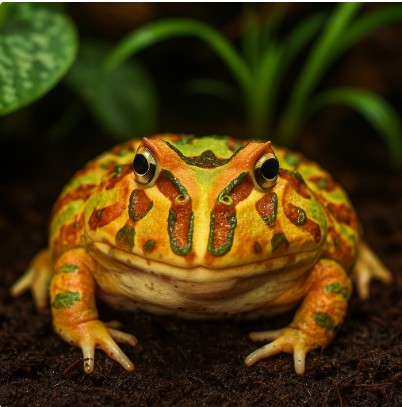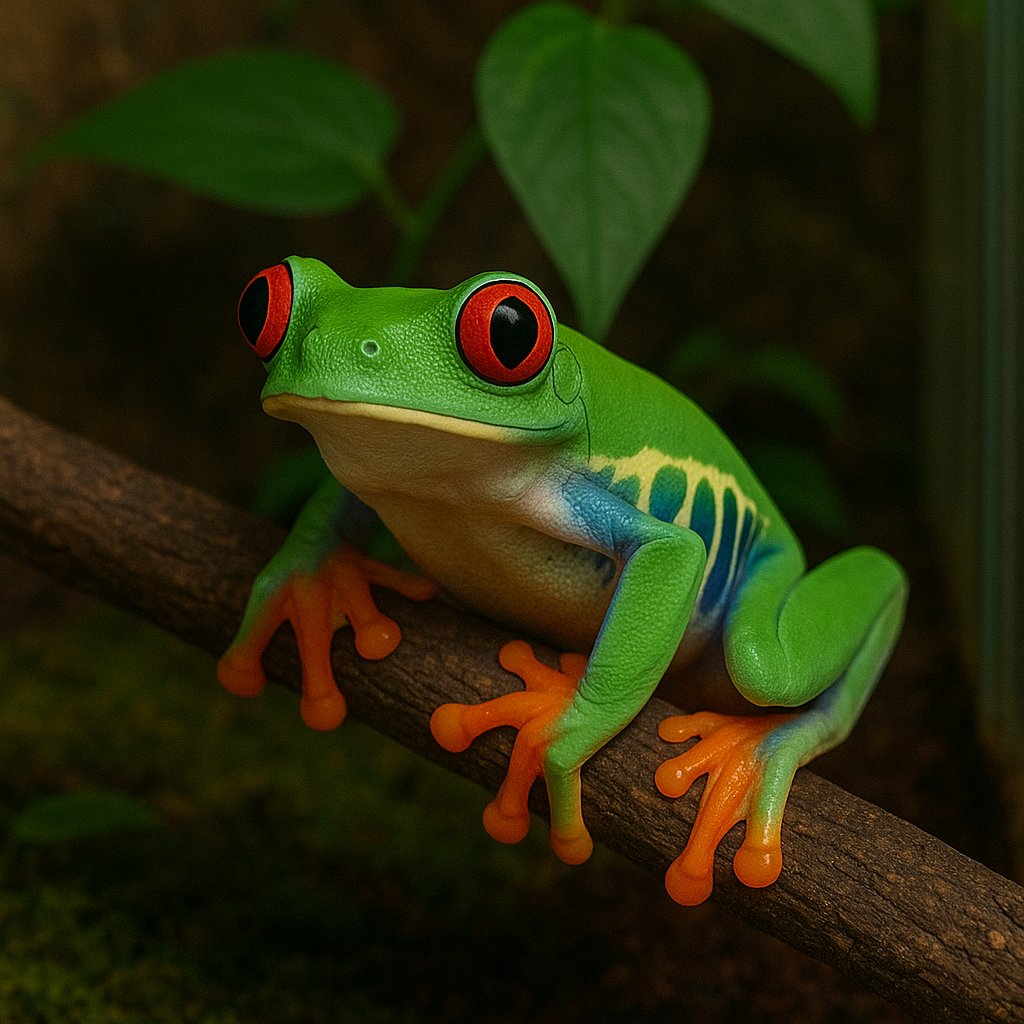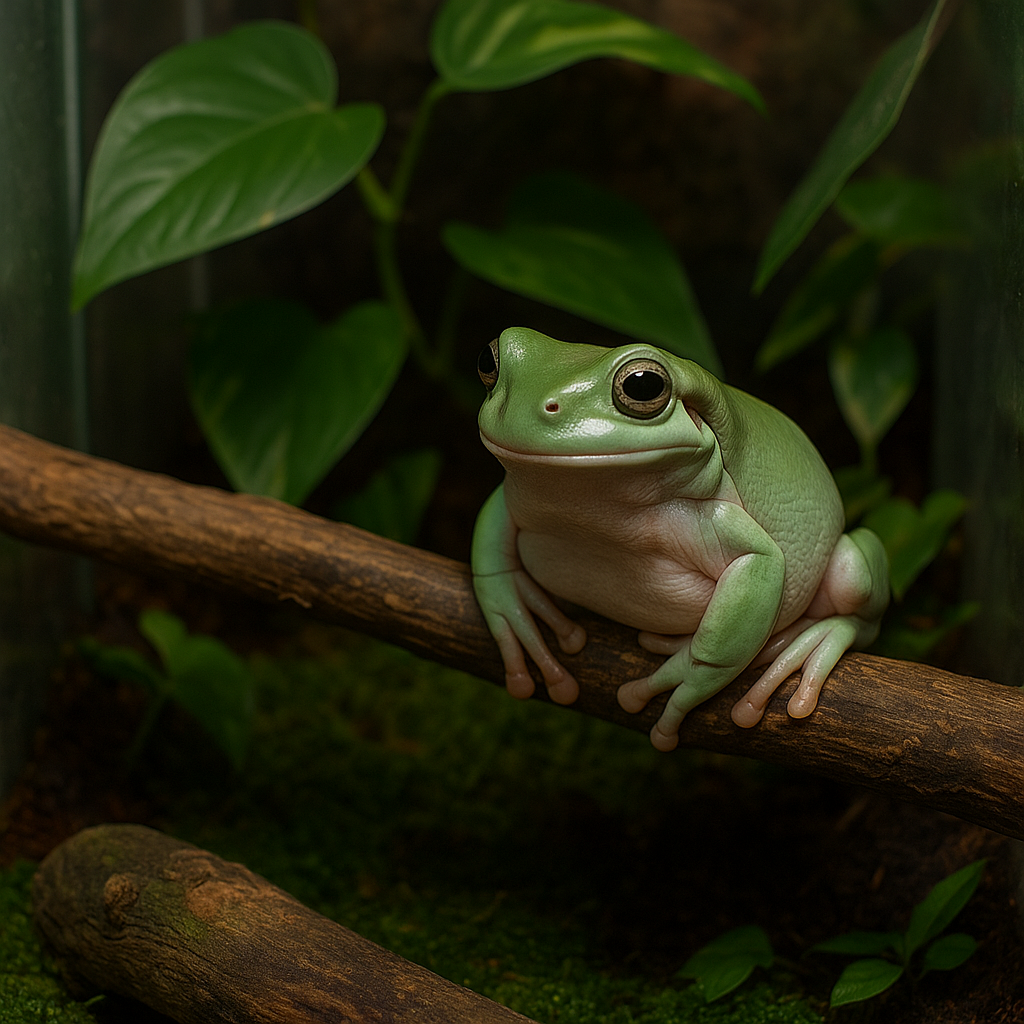If you’ve ever looked at a frog and thought, “that looks like a round mouth with legs,” then congratulations — you’ve just met the Pac-Man frog. These chunky, bold amphibians are loved by exotic pet keepers across the world for their comical appearance, low activity level, and simple setup needs.
But what do Pac-Man frogs actually need to thrive in the UK? How often do they eat? And how do they compare to dart frogs, neon day geckos, or even chameleons?
Let’s dig in.
What is a Pac-Man Frog?
The Pac-Man frog isn’t just one species — it’s a nickname for a group of South American frogs in the Ceratophrys genus, particularly:
- Ceratophrys ornata
- Ceratophrys cranwelli
- Ceratophrys cornuta
They’re known for their huge mouths, squat bodies, and ambush-hunting style. Their look is iconic: like someone drew a cartoon circle, gave it two eyes and a pair of legs, and let it eat everything in sight.

Popular Pac-Man Frog Morphs
Thanks to years of captive breeding, there are now loads of eye-catching morphs available:
🟡 Strawberry Albino – A bubblegum-pink frog with a bright golden hue.
🟠 High Red – Bright red or orange with heavy patterning.
🟢 Mint Green – A soft, pale green morph, common in Cranwelli lines.
🔵 Blue – A rarer morph that looks greyish-blue, often camera shy.
🍫 Chocolate – Deep brown with leaf-like camouflage.
🌀 Fantasy – A hybrid of two species, often larger and uniquely patterned.
Most morphs share the same care needs, though albinos may be slightly more sensitive to bright lights and heat.
Where Do Pac-Man Frogs Come From?
In the wild, Pac-Man frogs live across much of South America, especially:
- Northern Argentina
- Southern Brazil
- Uruguay
- Paraguay
- Bolivia
They prefer humid grasslands and forest floors — not trees or open water. You’ll often find them buried during the day, with just their eyes peeking out.
Are Pac-Man Frogs Nocturnal?
Yes, they’re mostly nocturnal. During the day, they stay buried or hidden, and at night they become active to hunt. That’s worth knowing if you’re expecting a frog that’s always visible — these are more lurk-and-strike than show-and-go.
What Do Pac-Man Frogs Eat?
Anything they can fit in their mouth — and sometimes things they can’t.
🪲 Insects: crickets, dubia roaches, locusts
🪱 Worms: earthworms, waxworms (in moderation)
🐭 Pinkie mice: for adults only, and not too often
🐸 Even small frogs or reptiles (if housed together — not recommended!)
They don’t chew — they gulp. Always feed appropriate sizes and dust live food with calcium and vitamins, especially for juveniles.
Feeding Frequency
- Juveniles (under 6 months): every 1–2 days
- Adults: every 3–4 days
- Breeding season or underweight frogs: slightly more frequent
Overfeeding is a real risk. These frogs can and will get obese.
Ideal Enclosure Setup (UK Conditions)
Your Pac-Man frog’s setup doesn’t need to be fancy — but it does need to be stable.
🔸 Minimum Vivarium Size
- For one adult: 45x45x30 cm
- A 60x45x45 cm tank allows better burrowing and plant room
- Never house them together! They will fight or eat each other.
🔸 Substrate
- Coco fibre (coir)
- Organic topsoil (no fertilisers)
- Sphagnum moss (optional)
- Leaf litter
Make it deep enough to burrow — at least 5–10 cm.
🔸 Temperature
- Daytime: 24°C to 28°C
- Night: down to 21°C
- Use a thermostat-controlled heat mat (side or bottom)
🔸 Humidity
- 70–80%
- Mist daily, especially in winter when UK heating dries the air
- Use a shallow water dish for soaking — keep it clean
🔸 Lighting
UVB isn’t essential, but a 2.0 or 5.0 UVB bulb helps in bioactive setups. Avoid bright light for albino morphs.
Breeding Pac-Man Frogs
It’s a bit of a project. You’ll need to simulate dry and rainy seasons:
- Cool the frogs to 20°C for 4–6 weeks
- Then raise heat and mist heavily to mimic rain
- Males will grunt and call
- Females lay hundreds of eggs in water
The tadpoles hatch in 2–3 days and are surprisingly cannibalistic — so separate early if you want high survival rates.
Pac-Man vs Dart Frogs: Which Is Right for You?
| Trait | Pac-Man Frog | Dart Frog |
|---|---|---|
| Size | 10–15 cm | 2–5 cm |
| Activity | Nocturnal | Diurnal |
| Handling | Avoid | Avoid |
| Temperament | Solitary & territorial | Often communal |
| Setup | Simple, ground-dwelling | Bioactive, display-heavy |
| Diet | Carnivorous, large prey | Microfauna (springtails, flies) |
| Visibility | Low | High |
Pac-Man frogs are easier to maintain but not as active or “display friendly” as dart frogs. Think of them as living ornaments — not interactive pets.
Pac-Man vs Neon Day Geckos vs Chameleons
| Trait | Pac-Man | Neon Day Gecko | Chameleon |
|---|---|---|---|
| Lifestyle | Ground-dwelling | Arboreal | Arboreal |
| UVB | Optional | Yes | Yes |
| Handling | Avoid | Avoid | Minimal |
| Humidity | 70–80% | 60–80% | 50–70% |
| Diet | Insects, mice | Insects, nectar | Insects, some veg |
| Vivarium | Low and wide | Tall glass | Large mesh or hybrid |
Each has its niche. Pac-Man frogs are the least demanding, while geckos and chameleons offer more activity (and complexity) for more experienced keepers.
Final Thoughts
Pac-Man frogs are quirky, easy to care for, and great for anyone who loves frogs but doesn’t want a high-maintenance, hands-on pet. They’re ideal for UK conditions if you can maintain temperature and humidity — and they’re a brilliant contrast to the fast-moving world of dart frogs and arboreal reptiles.
Just remember: one frog per tank, feed appropriately, and don’t expect them to do much during the day. They’re little tanks that wait, lurk, and pounce — and that’s exactly why we love them.



